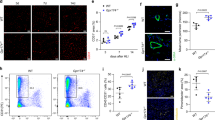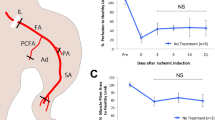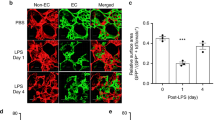Abstract
Infusion of endothelial progenitor cells (EPC), but not of mature endothelial cells, promotes neovascularization after ischemia. We performed gene expression profiling of EPC and endothelial cells to identify genes that might be important for the neovascularization capacity of EPC. Notably, the protease cathepsin L (CathL) was highly expressed in EPC as opposed to endothelial cells and was essential for matrix degradation and invasion by EPC in vitro. CathL-deficient mice showed impaired functional recovery following hind limb ischemia, supporting the concept of a crucial role for CathL in postnatal neovascularization. Infused CathL-deficient progenitor cells neither homed to sites of ischemia nor augmented neovascularization. Forced expression of CathL in mature endothelial cells considerably enhanced their invasive activity and sufficed to confer their capacity for neovascularization in vivo. We concluded that CathL has a critical role in the integration of circulating EPC into ischemic tissue and is required for EPC-mediated neovascularization.
This is a preview of subscription content, access via your institution
Access options
Subscribe to this journal
Receive 12 print issues and online access
$209.00 per year
only $17.42 per issue
Buy this article
- Purchase on Springer Link
- Instant access to full article PDF
Prices may be subject to local taxes which are calculated during checkout






Similar content being viewed by others
Accession codes
References
Isner, J.M. & Asahara, T. Angiogenesis and vasculogenesis as therapeutic strategies for postnatal neovascularization. J. Clin. Invest. 103, 1231–1236 (1999).
Folkman, J. Angiogenesis in cancer, vascular, rheumatoid and other disease. Nat. Med. 1, 27–31 (1995).
Risau, W. Mechanisms of angiogenesis. Nature 386, 671–674 (1997).
Carmeliet, P. & Jain, R.K. Angiogenesis in cancer and other diseases. Nature 407, 249–257 (2000).
Asahara, T. et al. Isolation of putative progenitor endothelial cells for angiogenesis. Science 275, 964–967 (1997).
Shi, Q. et al. Evidence for circulating bone marrow-derived endothelial cells. Blood 92, 362–367 (1998).
Kalka, C. et al. Transplantation of ex vivo expanded endothelial progenitor cells for therapeutic neovascularization. Proc. Natl. Acad. Sci. USA 97, 3422–3427 (2000).
Kawamoto, A. et al. Therapeutic potential of ex vivo expanded endothelial progenitor cells for myocardial ischemia. Circulation 103, 634–647 (2001).
Assmus, B. et al. Transplantation of Progenitor Cells and Regeneration Enhancement in Acute Myocardial Infarction (TOPCARE-AMI). Circulation 106, 3009–3017 (2002).
Kocher, A.A. et al. Neovascularization of ischemic myocardium by human bone-marrow-derived angioblasts prevents cardiomyocyte apoptosis, reduces remodeling and improves cardiac function. Nat. Med. 7, 430–436 (2001).
Joyce, J.A. et al. Cathepsin cysteine proteases are effectors of invasive growth and angiogenesis during multistage tumorigenesis. Cancer Cell 5, 443–453 (2004).
Berchem, G. et al. Cathepsin-D affects multiple tumor progression steps in vivo: proliferation, angiogenesis and apoptosis. Oncogene 21, 5951–5955 (2002).
Krueger, S., Kellner, U., Buehling, F. & Roessner, A. Cathepsin L antisense oligonucleotides in a human osteosarcoma cell line: effects on the invasive phenotype. Cancer Gene Ther. 8, 522–528 (2001).
Dimmeler, S. et al. HMG-CoA reductase inhibitors (statins) increase endothelial progenitor cells via the PI 3-kinase/Akt pathway. J. Clin. Invest. 108, 391–397. (2001).
Vasa, M. et al. Number and migratory activity of circulating endothelial progenitor cells inversely correlate with risk factors for coronary artery disease. Circ. Res. 89, E1–7 (2001).
Urbich, C. et al. Relevance of monocytic features for neovascularization capacity of circulating endothelial progenitor cells. Circulation 108, 2511–2516 (2003).
Fiebiger, E. et al. Invariant chain controls the activity of extracellular cathepsin L. J. Exp. Med. 196, 1263–1269 (2002).
Walker, B., Lynas, J.F., Meighan, M.A. & Bromme, D. Evaluation of dipeptide alpha-keto-beta-aldehydes as new inhibitors of cathepsin S. Biochem. Biophys. Res. Commun. 275, 401–405 (2000).
Li, Z. et al. Regulation of collagenase activities of human cathepsins by glycosaminoglycans. J. Biol. Chem. 279, 5470–5479 (2004).
Chauhan, S.S., Ray, D., Kane, S.E., Willingham, M.C. & Gottesman, M.M. Involvement of carboxy-terminal amino acids in secretion of human lysosomal protease cathepsin L. Biochemistry 37, 8584–8594 (1998).
Libby, P. & Schonbeck, U. Drilling for oxygen: angiogenesis involves proteolysis of the extracellular matrix. Circ. Res. 89, 195–197 (2001).
Carmeliet, P. Mechanisms of angiogenesis and arteriogenesis. Nat. Med. 6, 389–395 (2000).
Devy, L. et al. The pro- or antiangiogenic effect of plasminogen activator inhibitor 1 is dose dependent. FASEB J. 16, 147–154 (2002).
Rooprai, H.K. & McCormick, D. Proteases and their inhibitors in human brain tumours: a review. Anticancer Res. 17, 4151–4162 (1997).
Turk, V., Turk, B. & Turk, D. Lysosomal cysteine proteases: facts and opportunities. EMBO J. 20, 4629–4633 (2001).
Stypmann, J. et al. Dilated cardiomyopathy in mice deficient for the lysosomal cysteine peptidase cathepsin L. Proc. Natl. Acad. Sci. USA 99, 6234–6239 (2002).
Tobin, D.J. et al. The lysosomal protease cathepsin L is an important regulator of keratinocyte and melanocyte differentiation during hair follicle morphogenesis and cycling. Am. J. Pathol. 160, 1807–1821 (2002).
Shi, G.P. et al. Deficiency of the cysteine protease cathepsin S impairs microvessel growth. Circ. Res. 92, 493–500 (2003).
Lyden, D. et al. Impaired recruitment of bone-marrow-derived endothelial and hematopoietic precursor cells blocks tumor angiogenesis and growth. Nat. Med. 7, 1194–1201 (2001).
Rafii, S., Lyden, D., Benezra, R., Hattori, K. & Heissig, B. Vascular and haematopoietic stem cells: novel targets for anti-angiogenesis therapy? Nat. Rev. Cancer 2, 826–835 (2002).
Nakagawa, T. et al. Cathepsin L: critical role in Ii degradation and CD4 T cell selection in the thymus. Science 280, 450–453 (1998).
Roth, W. et al. Cathepsin L deficiency as molecular defect of furless: hyperproliferation of keratinocytes and pertubation of hair follicle cycling. FASEB J. 14, 2075–2086 (2000).
Houseweart, M.K. et al. Cathepsin B but not cathepsins L or S contributes to the pathogenesis of Unverricht-Lundborg progressive myoclonus epilepsy (EPM1). J. Neurobiol. 56, 315–327 (2003).
Saftig, P. et al. Mice deficient for the lysosomal proteinase cathepsin D exhibit progressive atrophy of the intestinal mucosa and profound destruction of lymphoid cells. EMBO J. 14, 3599–3608 (1995).
Lelongt, B. et al. Matrix metalloproteinase 9 protects mice from anti-glomerular basement membrane nephritis through its fibrinolytic activity. J. Exp. Med. 193, 793–802 (2001).
Urbich, C. et al. Dephosphorylation of endothelial nitric oxide synthase contributes to the anti-angiogenic effects of endostatin. FASEB J. 16, 706–708 (2002).
Premzl, A., Zavasnik-Bergant, V., Turk, V. & Kos, J. Intracellular and extracellular cathepsin B facilitate invasion of MCF-10A neoT cells through reconstituted extracellular matrix in vitro. Exp. Cell. Res. 283, 206–214 (2003).
Aicher, A. et al. Essential role of endothelial nitric oxide synthase for mobilization of stem and progenitor cells. Nat. Med. 9, 1370–1376 (2003).
Dennhofer, R. et al. Invasion of melanoma cells into dermal connective tissue in vitro: evidence for an important role of cysteine proteases. Int. J. Cancer 106, 316–323 (2003).
Kaberdin, V.R. & McDowall, K.J. Expanding the use of zymography by the chemical linkage of small, defined substrates to the gel matrix. Genome Res. 13, 1961–1965 (2003).
Hinds, K.A. et al. Highly efficient endosomal labeling of progenitor and stem cells with large magnetic particles allows magnetic resonance imaging of single cells. Blood 102, 867–872 (2003).
Acknowledgements
We are thankful to J. Gille (University of Frankfurt, Frankfurt, Germany) and Z. Werb (University of California, San Francisco, California) for providing the MMP9-deficient mice. DCG-04 was donated by M. Bogyo (Stanford University Medical School, California). We would like to thank A. Knau, M. Näher, and M. Muhly-Reinholz for technical help. This study was supported by the Deutsche Forschungsgemeinschaft (Di 600/4-1, He 3044/2-2 and VA151/4-3), the Alfried Krupp Stiftung (S.D.), the Fonds der Chemischen Industrie (T.R. and C.P.), by the Deutsche Krebshilfe (T.R.), and in part by National Institutes of Health Grant HL071954A (DE-AC03-76SF00098 (L.A.P.)). K.S was in part supported by the Japan Heart Foundation/Bayer Yakuhin Research Grant Abroad. The authors C.U., C.H., A.A., T.B., A.M.Z. and S.D. belong to the European Vascular Genomics Network (http://www.evgn.org) a Network of Excellence supported by the European Community's sixth Framework Programme for Research Priority 1 “Life sciences, genomics and biotechnology for health” (Contract number LSHM-CT-2003-503254).
Author information
Authors and Affiliations
Corresponding author
Ethics declarations
Competing interests
The authors declare no competing financial interests.
Supplementary information
Supplementary Fig. 1
Effect of lymphocyte infusion on neovascularization. (PDF 126 kb)
Supplementary Fig. 2
Expression of cathepsin L on different cell types. (PDF 36 kb)
Supplementary Fig. 3
Effect of cathepsin L on progenitor cell function. (PDF 23 kb)
Supplementary Fig. 4
Role of cathepsin L in mature endothelial cell function. (PDF 45 kb)
Supplementary Fig. 5
Proteolytic activity of EPC and progenitor cells in lysates and supernatants. (PDF 25 kb)
Supplementary Fig. 6
Confocal proteolysis assay. (PDF 73 kb)
Supplementary Fig. 7
Histological evaluation of tissue vascularization—capillary density. (PDF 317 kb)
Supplementary Fig. 8
Histological evaluation of tissue vascularization—conductance vessels. (PDF 59 kb)
Supplementary Fig. 9
Role of cathepsin L in progenitor cell–induced perfusion. (PDF 296 kb)
Supplementary Fig. 10
Incorporation of endothelial progenitor cells. (PDF 101 kb)
Supplementary Fig. 11
Role of cathepsin L in tumor vascularization. (PDF 417 kb)
Supplementary Fig. 12
Role of cathepsin L in incorporation of bone marrow cells. (PDF 63 kb)
Supplementary Fig. 13
MMP-9 and cathepsin L activity in ischemic tissues. (PDF 24 kb)
Supplementary Table 1
The mRNA expression (normalized data) of various proteases and protease inhibitors in EPC, HUVEC and monocytes is summarized. n = 3; *P < 0.05 versus HUVEC. (PDF 19 kb)
Supplementary Movie 1
Incorporation of endothelial progenitor cells (AVI 15480 kb)
Rights and permissions
About this article
Cite this article
Urbich, C., Heeschen, C., Aicher, A. et al. Cathepsin L is required for endothelial progenitor cell–induced neovascularization. Nat Med 11, 206–213 (2005). https://doi.org/10.1038/nm1182
Received:
Accepted:
Published:
Issue Date:
DOI: https://doi.org/10.1038/nm1182
This article is cited by
-
Overview of multifunctional cysteinyl cathepsins in atherosclerosis-based cardiovascular disease: from insights into molecular functions to clinical implications
Cell & Bioscience (2023)
-
Human Endothelial Colony Forming Cells Express Intracellular CD133 that Modulates their Vasculogenic Properties
Stem Cell Reviews and Reports (2019)
-
Cellular proliferation in mouse and human pancreatic islets is regulated by serpin B13 inhibition and downstream targeting of E-cadherin by cathepsin L
Diabetologia (2019)
-
Cysteine protease cathepsins in cardiovascular disease: from basic research to clinical trials
Nature Reviews Cardiology (2018)
-
Egfl7 Represses the Vasculogenic Potential of Human Endothelial Progenitor Cells
Stem Cell Reviews and Reports (2018)



